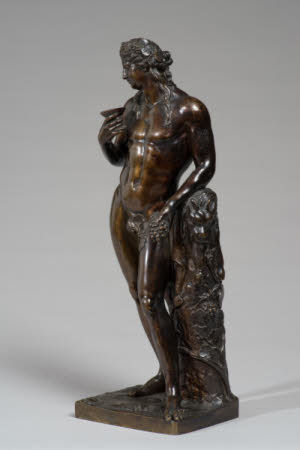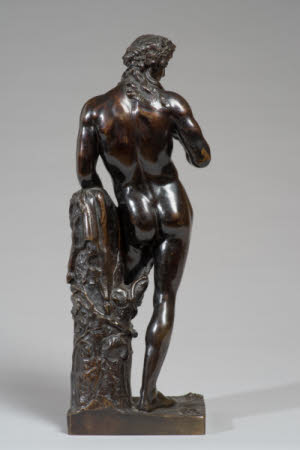Bacchus
after Louis Garnier (c.1639 - 1728)
Category
Art / Sculpture
Date
1685 - 1695 (model) - 1690 - 1700 (cast)
Materials
Bronze
Measurements
365 x 126 x 102 mm
Place of origin
Paris
Order this imageCollection
Anglesey Abbey, Cambridgeshire
NT 515056
Summary
Bronze, Bacchus, after a model by Louis Garnier (c. 1639-1728), Paris, France, model probably c. 1685-95, cast probably c. 1690-1700. A bronze standing figure of Bacchus, god of wine, after a model by Louis Garnier. The figure is paired with a statuette of Amphitrite (NT 515055), after Michel Anguier (1612/14- 1686). These very fine bronze figures were probably cast in the late 17th century. Bacchus stands naked, vine leaves in his long hair, which is tied at back with a ribbon, looking to his right, holding a bunch of grapes in left hand and a kylix or drinking bowl in right hand. He stands against a tree trunk, which is covered at top with an animal skin. A vine plant grows against the trunk, one branch running up behind Bacchus’s legs, its outer tendril curling up his inside leg so that its leaves form a cache-sexe. The rectangular terrasse with slightly canted edges is decorated with whorls of plants, and has a threaded cavity in its centre, presumably for fixing the statuette with a screw to a base. The hollow interior of the bronze is cleanly finished, with a large cavity for the tree trunk, and remains of a metal armature. The Bacchus is as carefully finished as its companion figure of Amphitrite, and with a similar golden red bronze colour, overlaid with a blackish lacquer, that partly survives.
Full description
The statuette depicts Bacchus the god of wine, depicted with his usual attributes of wine cup, vine leaves and animal skin. It is usually found paired with a reduced-size version of Michel Anguier’s Amphitrite (NT 515055), a figure conceived in the early 1650s as part of Anguier’s series of statuettes of gods and goddeses. The figure is attributed to Louis Garnier, about whom relatively little is known. He was however a specialist in bronze sculpture who was employed by François Girardon, sculptor to Louis XIV during the last decades of the seventeenth century. Garnier’s best-known work is the so-called Parnasse français at the Château de Versailles, a very large and elaborate bronze group made between 1718-21 to the commission of Evrard Titon du Tillet, which celebrates the achievements of artists, musicians and writers of the reign of Louis XIV. Garnier, and his authorship of the Bacchus, are sometimes confused with another contemporary sculptor, Pierre Granier (1635-1715). The notion of the pairing may have been a commercial venture, perhaps initiated after Michel Anguier’s death in 1686, in which Garnier had some active part in designing a new figure to match the Amphitrite, Anguier’s most popular and successful model. The Bacchus certainly corresponds closely in size to the Amphitrite, whilst Bacchus’s pose and his gaze to his right seem designed to complement the other figure. However, the most important element in support of the notion that the Bacchus might have been specifically modelled to act as a pendant is the drinking cup held in Bacchus’s raised right hand, which cleverly echoes the crayfish in Amphitrite’s left hand. The two bronzes in this pairing are first documented in 1699, when a pair was acquired in Paris for the collections of the Electors of Saxony in Dresden (today in the Grünes Gewölbe, Dresden; see Krahn 1995, pp. 568-71, nos. 218-19). The Anglesey Abbey Amphitrite and Bacchus, superior in their quality to the pair in Dresden, are among the finest examples of the models at this size to survive. The surfaces are exceptionally carefully worked with tools such as small chisels and hammers, to produce a variegated effect that would have appeared even more magical, when the bronzes were illuminated by the flickering lights of candles. They also have a reddish varnish applied their surfaces, over this a blackish lacquer, a practice seen in French bronzes from the 16th and 17th centuries. A pair close in quality was sold by Sotheby’s in 2015 (Important Mobilier, Sculptures et Orfèvrerie Européenne, Sotheby’s Paris, 4-5 November 2015, lot 301). Jeremy Warren 2020
Provenance
Acquired by Huttleston Rogers Broughton, 1st Lord Fairhaven (1896-1966) between 1932 and 1940; identifiable in the Anglesey Abbey inventory 1940, p. 75, Main Landing and stairs to upper floors, valued with NT 515055 at £21; bequeathed to the National Trust by Lord Fairhaven in 1966 with the house and the rest of the contents.
Credit line
Anglesey Abbey, The Fairhaven Collection (The National Trust)
Makers and roles
after Louis Garnier (c.1639 - 1728), sculptor
References
Krahn 1995: Volker Krahn (ed.), Von allen Seiten Schön. Bronzen der Renaissance und des Barock, exh. cat., Altes Museum, Berlin, Heidelberg 1995, pp. 568-71, nos. 218-19. 'Anglesey Abbey, Lode, Cambridgeshire. An Inventory and Valuation of Furniture, Books, Ornamental Items & Household Effects .. prepared for Insurance Purposes’, Turner, Lord and Ransom, April 1940, p. 75. Christie, Manson & Woods 1971: The National Trust, Anglesey Abbey, Cambridge. Inventory: Furniture, Textiles, Porcelain, Bronzes, Sculpture and Garden Ornaments’, 1971, p. 152.






